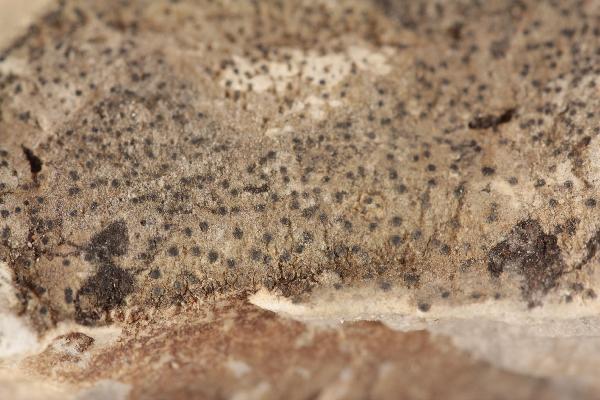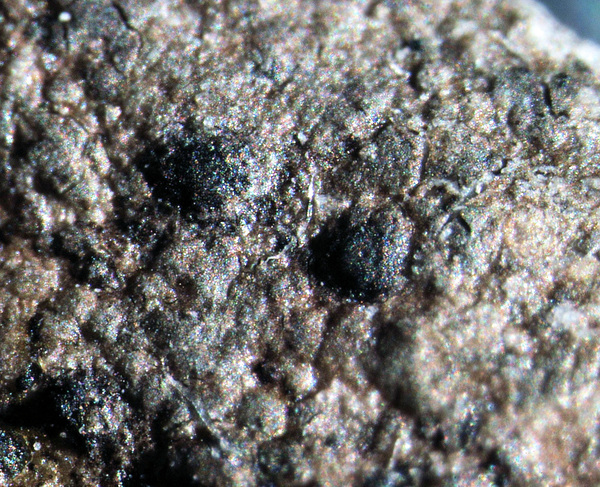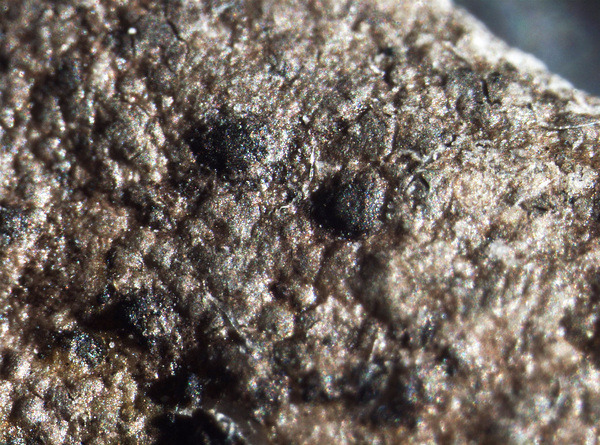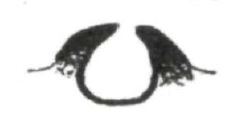Thelidium auruntii (A. Massal.) Kremp.
Denkschr. kgl. bayer. bot. Ges., Abt. 2 4: 248, 1861. Basionym: Verrucaria auruntii A. Massal. - Symmicta Lich: 77, 1855.
Synonyms:
Description: Thallus crustose, thinly episubstratic, more or less continuous, dark brown to almost black. Perithecia black, sparse, 0.3-0.4(-0.5) mm across, half immersed in the thallus, the emerging part hemispherical, smooth, sometimes slightly flattened at top. Involucrellum limited to the upper half of the perithecium, adpressed to exciple; exciple brown to brown-black throughout; hamathecium of periphyses and periphysoids, interascal filaments absent; hymenial gel I+ red (I+ blue at very low concentrations of I), K/I+ blue. Asci 8-spored, ellipsoid to clavate, I-, fissitunicate, the wall thickened above, with an ocular chamber, dehiscent by extrusion of a delicate rostrum. Ascospores 1-septate, hyaline, ellipsoid, 23-35 x 9-12(-15) μm. Photobiont chlorococcoid. Spot tests: K-, C-, KC-, P-, UV-. Chemistry: without lichen substances.
Growth form: Crustose
Substrata: rocks
Photobiont: green algae other than Trentepohlia
Reproductive strategy: mainly sexual
Commonnes-rarity: (info)
Alpine belt: very rare
Subalpine belt: very rare
Montane belt: very rare
Dry submediterranean belt: absent
Humid submediterranean belt: absent
Padanian area: absent
pH of the substrata:
1 2 3 4 5
Solar irradiation:
1 2 3 4 5
Aridity:
1 2 3 4 5
Eutrophication:
1 2 3 4 5
Poleotolerance:
0 1 2 3
Altitudinal distribution:
1 2 3 4 5 6
Rarity
absent
extremely rare
very rare
rare
rather rare
rather common
common
very common
extremely common
Loading data...
Occurrence data
Predictive map

Collezione lichenologica Abramo Massalongo del Museo di Storia Naturale G. Ligabue di Venezia - Autori: Seggi, Linda; Trabucco, Raffaella Proprietà: Fondazione Musei Civici di Venezia - CC BY-NC
Italy, Veneto, n opp. Auronzo Cadubriae 1855
as Verrucaria auruntii ISOTYPE
Growth form: Crustose
Substrata: rocks
Photobiont: green algae other than Trentepohlia
Reproductive strategy: mainly sexual
Commonnes-rarity: (info)
Alpine belt: very rare
Subalpine belt: very rare
Montane belt: very rare
Dry submediterranean belt: absent
Humid submediterranean belt: absent
Padanian area: absent
pH of the substrata:
| 1 | 2 | 3 | 4 | 5 |
Solar irradiation:
| 1 | 2 | 3 | 4 | 5 |
Aridity:
| 1 | 2 | 3 | 4 | 5 |
Eutrophication:
| 1 | 2 | 3 | 4 | 5 |
Poleotolerance:
| 0 | 1 | 2 | 3 |
Altitudinal distribution:
| 1 | 2 | 3 | 4 | 5 | 6 |
Rarity
absent
extremely rare
very rare
rare
rather rare
rather common
common
very common
extremely common
Loading data...
Occurrence data
Predictive map











